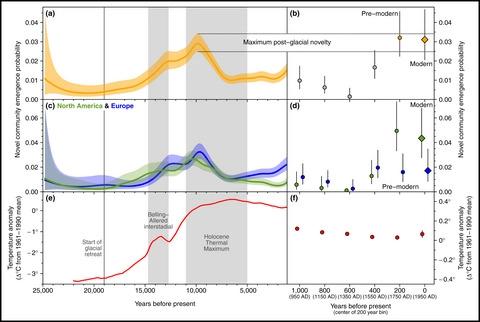当前位置:
X-MOL 学术
›
Ecol. Lett.
›
论文详情
Our official English website, www.x-mol.net, welcomes your
feedback! (Note: you will need to create a separate account there.)
Emergence patterns of locally novel plant communities driven by past climate change and modern anthropogenic impacts
Ecology Letters ( IF 7.6 ) Pub Date : 2022-05-11 , DOI: 10.1111/ele.14016 Timothy L Staples 1 , Wolfgang Kiessling 2 , John M Pandolfi 1
Ecology Letters ( IF 7.6 ) Pub Date : 2022-05-11 , DOI: 10.1111/ele.14016 Timothy L Staples 1 , Wolfgang Kiessling 2 , John M Pandolfi 1
Affiliation

|
Anthropogenic disturbance and climate change can result in dramatic increases in the emergence of new, ecologically novel, communities of organisms. We used a standardised framework to detect local novel communities in 2135 pollen time series over the last 25,000 years. Eight thousand years of post-glacial warming coincided with a threefold increase in local novel community emergence relative to glacial estimates. Novel communities emerged predominantly at high latitudes and were linked to global and local temperature change across multi-millennial time intervals. In contrast, emergence of locally novel communities in the last 200 years, although already on par with glacial retreat estimates, occurred at midlatitudes and near high human population densities. Anthropogenic warming does not appear to be strongly associated with modern local novel communities, but may drive widespread emergence in the future, with legacy effects for millennia after warming abates.
中文翻译:

受过去气候变化和现代人为影响驱动的当地新型植物群落的出现模式
人为干扰和气候变化可导致新的、生态新颖的生物群落的出现急剧增加。我们使用标准化框架在过去 25,000 年的 2135 个花粉时间序列中检测本地新群落。八千年后的冰川变暖恰逢当地新社区的出现相对于冰川估计增加了三倍。新社区主要出现在高纬度地区,并与跨千年时间间隔的全球和当地温度变化有关。相比之下,在过去的 200 年中,虽然已经与冰川退缩的估计相提并论,但在中纬度地区和接近高人口密度的地方出现了当地新社区。
更新日期:2022-05-11
中文翻译:

受过去气候变化和现代人为影响驱动的当地新型植物群落的出现模式
人为干扰和气候变化可导致新的、生态新颖的生物群落的出现急剧增加。我们使用标准化框架在过去 25,000 年的 2135 个花粉时间序列中检测本地新群落。八千年后的冰川变暖恰逢当地新社区的出现相对于冰川估计增加了三倍。新社区主要出现在高纬度地区,并与跨千年时间间隔的全球和当地温度变化有关。相比之下,在过去的 200 年中,虽然已经与冰川退缩的估计相提并论,但在中纬度地区和接近高人口密度的地方出现了当地新社区。











































 京公网安备 11010802027423号
京公网安备 11010802027423号